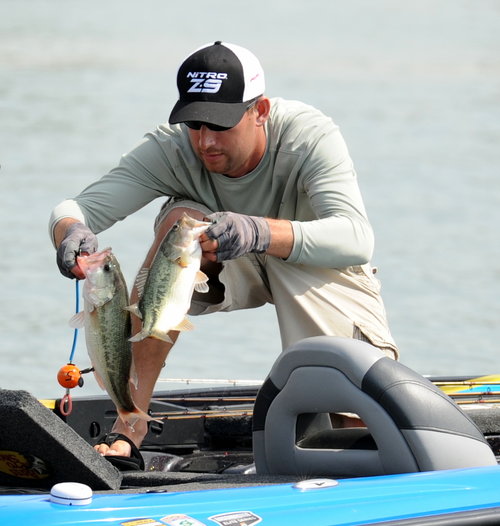Summertime is Structure Fishing Nirvana at Douglas and Cherokee
By Pete Robbins
In the heat of the summer, it can seem like every pleasure boat owner and jet skier in the Volunteer State descends upon East Tennessee’s scenic mountain lakes, but bass anglers who choose to avoid the crowds are missing out on some of the best fishing of the year. Knoxville native Ott DeFoe, the 2019 Bassmaster Classic champion, said “now is the prime of the offshore fishing season.”
He said that it pays to be well-versed in your electronics, because many times the fish won’t be relating as much to cover as they are to bait schools and drops. You’ll want to scan around long points, drop-offs, humps and saddles, but bait is often the key.
“These are some of the best lakes in the county for finding fish on your electronics,” he said. “Often I don’t bother fishing until I see the fish.”
The biggest difference between Cherokee and Douglas is the depths at which the bass will congregate. On Cherokee, he might find smallmouths out to 35 feet, but normally they’re in the 25 to 28 foot range. The lake’s lower end largemouths are more likely to be in 12 to 18 foot depths, and “you don’t have to go over 20.” Meanwhile, on Douglas, his down lake largemouth fishing will often start in 20 feet and go out into the 40 foot depths.
Whenever the fish are aggressive, DeFoe’s favorite way to catch them this time of year is on a crankbait, which elicits reaction strikes. He’ll go as shallow as a DT10, but more often relies on a DT16 or DT20 in shad patterns like Disco Shad and Caribbean Shad. If he finds some dirty water, he might also work chartreuse with a blue back into the mix. If he can hit the bottom with a long cast, he employs a typical retrieve, but Douglas is the lake that brought “longlining” into the national spotlight. As long as you’re not fishing a tournament that prohibits this technique – letting out line and then using the trolling motor to move a long distance away before starting your retrieve – it remains remarkably effective. If the fish won’t bite a moving crankbait, a spoon can generate bites, as can a number of bottom-bouncing techniques.
While the structure fishing is exceptional on both lakes, if that’s not your game there can still be a quality bite up the lake, specifically in their river sections. With both Douglas and Cherokee at summer pool, their upper ends have substantial flooded grass, buck brush and willow bushes. Additionally, the water levels enable even non-local boaters to go pretty far without risking danger. You’ll need to use your mapping and exercise some caution, but DeFoe said that “when the lake is full you can go pretty much anywhere it looks like you can. There are not a lot of hazardous places that aren’t obvious.”
Up in the moving, oxygenated water, he flips and throws a frog like a Terminator Popping Frog or Walking Frog Jr. It’s one of the most exciting ways to fish and the fish rely on current breaks to ambush their prey, meaning that you can often call your shot. If you find vestiges of a shad spawn, you can add a bladed jig to the mix, and while DeFoe hasn’t chased it here himself, he’s sure that somewhere on the lakes there are bass gorging themselves in and around bluegill beds.
If you decide to head up the lake, you’ll also avoid much of the boat traffic that comes to enjoy this summertime wonderland. Get up toward Highway 25 on both lakes and you’re likely to have the water mostly to yourself. In fact, that’s the recipe for a perfect summer day on the lake – start down, near the dam, and feast on bass relating to structure and then head up to avoid the crowds and enjoy the shallow bite. Or do one the first day and the other the second. The options are equally enticing, and both can put you on the fishing day of a lifetime.
Ready to grab your tackle box and get going? Visit Jefferson County, TN, and take advantage of the fishing nirvana its lakes provide. As a matter of fact, stay a while and grab a bite to eat at a local restaurant or take advantage of the other opportunities available to play in the area!
About the Author:
Pete Robbins is the writer of “Pete Weighs In,” a blog on insideline.net, that looks to give the average fishing fan a voice. “Pete Weighs In” touches on all aspects of fishing, from new tackle to tournament results to industry trends.

